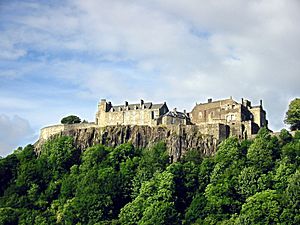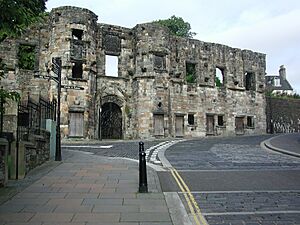Battle of Stirling (1648) facts for kids
Quick facts for kids Battle of Stirling |
|||||||
|---|---|---|---|---|---|---|---|
| Part of the Scottish Civil War | |||||||
 Stirling Castle |
|||||||
|
|||||||
| Belligerents | |||||||
(under the overall command of the Earl of Lanark) |
(under the overall command of the Marquess of Argyll) |
||||||
| Commanders and leaders | |||||||
| Strength | |||||||
| 10,000 | 1,000 | ||||||
| Casualties and losses | |||||||
| Unknown | 200 killed 400 captured (according to Keltie) 700 killed (according to Wheeler) |
||||||
The second Battle of Stirling happened on September 12, 1648. It was a fight during the Scottish Civil War in the 1600s. This battle was between two groups of Scottish Covenanters.
One group was called the Engagers. They were led by George Munro, 1st of Newmore. The Engagers had made a deal, called "The Engagement," with King Charles I of England in 1647. The other group was the Kirk Party. They were a very religious group of Covenanters, led by Archibald Campbell, 1st Marquess of Argyll.
Contents
Why Did the Battle of Stirling Happen?
The Battle of Stirling in 1648 was part of a bigger conflict called the War of the Three Kingdoms. At this time, the Covenanters, who were mostly Presbyterians, had already defeated the Scottish Royalists. The Royalists were people who strongly supported King Charles I of England.
In England, there was a group in Parliament called the Independents, along with their army, the New Model Army. These groups were a threat to what the Scots and English Presbyterians wanted. They hoped for a Presbyterian church to be set up in both Scotland and England.
What Was "The Engagement"?
One part of the Covenanters decided to make a deal with King Charles I. This deal was called "The Engagement." The King agreed to sign the National Covenant, which was a promise to support the Presbyterian church. In return, the Scots would help him and the English Presbyterians fight against the English Independents.
The Covenanters who supported this deal became known as the Engagers. Their army, led by the Duke of Hamilton, was later defeated by the New Model Army at the Battle of Preston (1648).
How Did the Kirk Party Rise?
After the Engagers lost at Preston, the Covenanters who had been against "The Engagement" saw their chance. They launched an attack called the Whiggamore Raid. This attack helped them take control of Edinburgh.
This event started a short civil war between the Engagers and their opponents, the Kirk Party. The Earl of Lanark, who was the Duke of Hamilton's younger brother, was left to defend Scotland. He faced Archibald Campbell, 1st Marquess of Argyll, a leading member of the Kirk Party. Argyll was now openly fighting against the Scottish parliament because of their deal with King Charles.
Argyll's fighting force started with about 300 men. Another 400 joined him on the way to Stirling. When he arrived in Stirling on the morning of September 12, 1648, 300 more local soldiers joined him. His men were placed to guard different parts of the town. Argyll and his main force then went to eat at the Earl of Mar's house.
The Battle Begins Unexpectedly

Argyll had just started his meal when the Engagers' advance troops arrived. These troops were led by Sir George Munro, 1st of Newmore, a Highlander. They entered the Deer Park, which is now called King's Park.
Argyll quickly got on his horse and rode across Stirling Bridge to find safety. As he was escaping, shots were fired at him from Stirling Castle. The castle had not yet surrendered to Argyll and was still flying the King's flag.
Munro's Surprise Attack
Sir George Munro learned that Argyll was in Stirling. He decided to act on his own and try to capture one of Argyll's commanders, a MacKenzie, who was his enemy. Munro actually managed to enter Stirling before any of Argyll's commanders even knew he was there. Munro even kicked down a small back door to chase out Argyll's men.
The battle completely surprised the Marquis of Argyll's men. After a short fight, they broke apart and ran. About 200 of Argyll's men were killed, and another 400 were taken prisoner. Many more died trying to escape, and some even drowned trying to swim across the River Forth to safety.
Among those who died on Argyll's side were William Campbell of Glenfalloch and Sir Colin Campbell of Ardkinglas. Dougal MacTavish, a younger son of the chief of Clan MacTavish, also died. The chief of Clan MacTavish lost most of his weapons in the battle. The Marquess of Argyll, who was the chief of Clan Campbell, gave him new weapons.
Outside Stirling, the Earl of Lanark had a large force of 4,000 horsemen and 6,000 foot soldiers. Argyll's General, David Leslie, commanded 3,000 horsemen and 8,000 foot soldiers, also outside Stirling. It makes you wonder what a huge battle would have happened the next day if Munro hadn't acted so quickly on September 12, 1648.
Munro wanted Lanark to keep fighting and attack David Leslie's forces. However, Lanark decided against it, and peace talks began on September 15. Both sides agreed to send their soldiers home by September 29, 1648.
What Happened After the Battle?
Soon after this battle, the armies of the Earl of Lanark and the Marquess of Argyll (led by David Leslie) made peace. They joined forces. On September 27, 1648, they agreed to the Treaty of Stirling. This treaty ended the Engagers' control over Scotland.
See also

